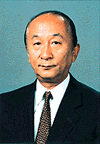|
|
 The
Future of Media and Our
Research Activities The
Future of Media and Our
Research Activities
By
Toyoaki HASEGAWA,
General Managing Director
and Executive Director-General
of Engineering, NHK
Digital satellite broadcasting
is one of the outstanding
results of our long research
activities. We started
the research after the
Tokyo Olympic in 1964
when studies on the color
television had matured
and we were trying to
find the next target for
our research. I think
that the current situation
is similar to that in
1964, because digital
technologies have matured
and we have to find a
new target that will support
NHK's services for a long
time in the future.
The driving force for
new research is divided
in two categories: needs-oriented
research based on the
desires of the society,
and seeds-oriented research
based on the foresight
of research scientists.
No matter which type of
research we pursue, the
following conditions must
be satisfied for its success:
- The research must be
based on social needs
or scientists' foresight,
- Surrounding technologies
must have high potential,
- Break-through technologies
must exist to make the
new service a reality.
The development of a television
system was needs-oriented
research, because there
was a clear demand for
television in society.
The surrounding technology
was high-frequency technology
such as radar and the
vacuum tube, and the break-through
technology was the pick-up
tube. These factors jointly
accelerated the research,
and finally led to the
great success of television
broadcasting.
On the other hand, satellite
broadcasting and HDTV
is seeds-oriented research.
There was no interest
among the people in satellite
broadcasting or HDTV,
but scientists pushing
the research were strongly
motivated. The surrounding
technology for satellite
broadcasting was the space
technology, and the break-through
technologies were receiving
circuits for the 12 GHz
band and high-power TWT.
However, no clear surrounding
technologies existed for
the HDTV, and, therefore,
we started from the basic
research. Also, there
was no single clear break-through
technology for the HDTV.
Instead, camera, recording,
and semiconductor technologies
worked jointly as the
break-through technology.
Based on the considerations
above, I would like to
discuss the future of
media and the direction
of our research. There
are three kinds of media:
broadcast, network, and
package media. Broadcast
media have the advantage
of real-time transmission
of high-quality video
at low cost. Network media
have interactive capability,
and package media storage
capability. I believe
each medium will evolve
by introducing the features
that it does not have
but other media have.
In the case of broadcast
media, this will gain
interactive and storage
capability, and will evolve
from being a passive media
toward becoming an active
media.
Integrated Services Digital
Broadcasting will turn
a television set from
a "passive box" into an
"active box", and will
make the broadcast media
a Dynamic Media. In this
context, the key themes
for research in the digital
age are copyright, archive,
middleware, indexing,
and better human interface.
The research toward the
Dynamic Media based on
these themes has both
needs-oriented and seeds-oriented
aspects.
The surrounding environment
for the research toward
the Dynamic Media is the
convergence of broadcasting,
communication, and computers,
and the rapid maturation
of software technology.
The break-through toward
the Dynamic Media will
take place when needs
of society and seeds from
the scientists are combined
with the technologies
that come from this environment.
During the period of high
economic growth, technology
had a close relationship
with the economy, because
it was the driving force
for economic growth. In
the digital age, we have
to put emphasis on the
relationship between technology
and culture, because the
contents of broadcasting
services are an important
part of our culture. From
this viewpoint, I believe
that contents-oriented
research will play a major
role in our future research
activities.
|

